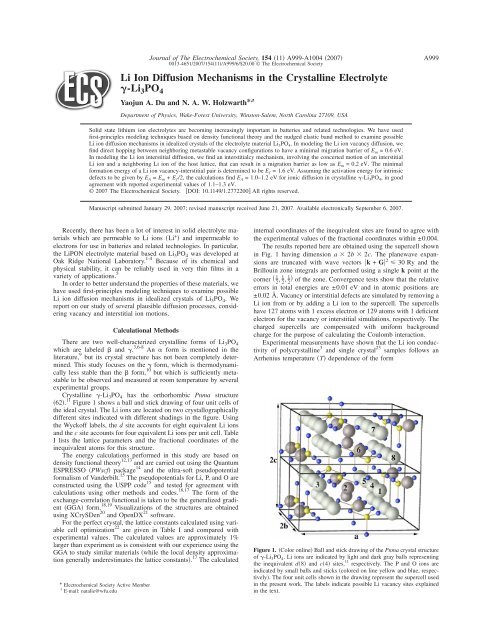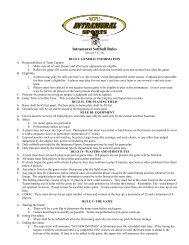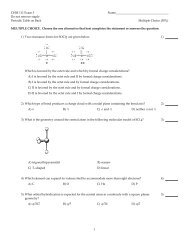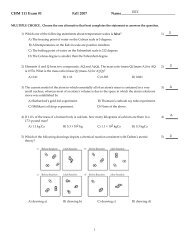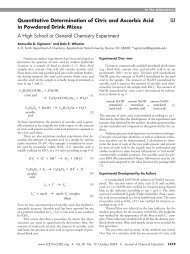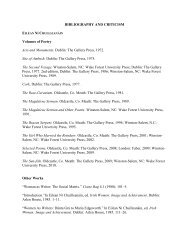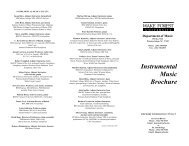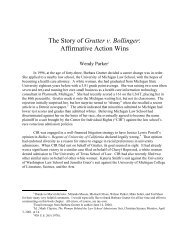Li Ion Diffusion Mechanisms in the Crystalline Electrolyte -Li3PO4
Li Ion Diffusion Mechanisms in the Crystalline Electrolyte -Li3PO4
Li Ion Diffusion Mechanisms in the Crystalline Electrolyte -Li3PO4
You also want an ePaper? Increase the reach of your titles
YUMPU automatically turns print PDFs into web optimized ePapers that Google loves.
<strong>Li</strong> <strong>Ion</strong> <strong>Diffusion</strong> <strong>Mechanisms</strong> <strong>in</strong> <strong>the</strong> Crystall<strong>in</strong>e <strong>Electrolyte</strong><br />
�-<strong>Li</strong> 3PO 4<br />
Yaojun A. Du and N. A. W. Holzwarth* ,z<br />
Department of Physics, Wake-Forest University, W<strong>in</strong>ston-Salem, North Carol<strong>in</strong>a 27109, USA<br />
Solid state lithium ion electrolytes are becom<strong>in</strong>g <strong>in</strong>creas<strong>in</strong>gly important <strong>in</strong> batteries and related technologies. We have used<br />
first-pr<strong>in</strong>ciples model<strong>in</strong>g techniques based on density functional <strong>the</strong>ory and <strong>the</strong> nudged elastic band method to exam<strong>in</strong>e possible<br />
<strong>Li</strong> ion diffusion mechanisms <strong>in</strong> idealized crystals of <strong>the</strong> electrolyte material <strong>Li</strong> 3PO 4. In model<strong>in</strong>g <strong>the</strong> <strong>Li</strong> ion vacancy diffusion, we<br />
f<strong>in</strong>d direct hopp<strong>in</strong>g between neighbor<strong>in</strong>g metastable vacancy configurations to have a m<strong>in</strong>imal migration barrier of E m = 0.6 eV.<br />
In model<strong>in</strong>g <strong>the</strong> <strong>Li</strong> ion <strong>in</strong>terstitial diffusion, we f<strong>in</strong>d an <strong>in</strong>terstitialcy mechanism, <strong>in</strong>volv<strong>in</strong>g <strong>the</strong> concerted motion of an <strong>in</strong>terstitial<br />
<strong>Li</strong> ion and a neighbor<strong>in</strong>g <strong>Li</strong> ion of <strong>the</strong> host lattice, that can result <strong>in</strong> a migration barrier as low as E m = 0.2 eV. The m<strong>in</strong>imal<br />
formation energy of a <strong>Li</strong> ion vacancy-<strong>in</strong>terstitial pair is determ<strong>in</strong>ed to be E f = 1.6 eV. Assum<strong>in</strong>g <strong>the</strong> activation energy for <strong>in</strong>tr<strong>in</strong>sic<br />
defects to be given by E A = E m + E f/2, <strong>the</strong> calculations f<strong>in</strong>d E A = 1.0–1.2 eV for ionic diffusion <strong>in</strong> crystall<strong>in</strong>e �-<strong>Li</strong> 3PO 4,<strong>in</strong>good<br />
agreement with reported experimental values of 1.1–1.3 eV.<br />
© 2007 The Electrochemical Society. �DOI: 10.1149/1.2772200� All rights reserved.<br />
Manuscript submitted January 29, 2007; revised manuscript received June 21, 2007. Available electronically September 6, 2007.<br />
Recently, <strong>the</strong>re has been a lot of <strong>in</strong>terest <strong>in</strong> solid electrolyte materials<br />
which are permeable to <strong>Li</strong> ions �<strong>Li</strong> + � and impermeable to<br />
electrons for use <strong>in</strong> batteries and related technologies. In particular,<br />
<strong>the</strong> <strong>Li</strong>PON electrolyte material based on <strong>Li</strong> 3PO 4 was developed at<br />
Oak Ridge National Laboratory. 1-4 Because of its chemical and<br />
physical stability, it can be reliably used <strong>in</strong> very th<strong>in</strong> films <strong>in</strong> a<br />
variety of applications. 5<br />
In order to better understand <strong>the</strong> properties of <strong>the</strong>se materials, we<br />
have used first-pr<strong>in</strong>ciples model<strong>in</strong>g techniques to exam<strong>in</strong>e possible<br />
<strong>Li</strong> ion diffusion mechanisms <strong>in</strong> idealized crystals of <strong>Li</strong> 3PO 4.We<br />
report on our study of several plausible diffusion processes, consider<strong>in</strong>g<br />
vacancy and <strong>in</strong>terstitial ion motions.<br />
Calculational Methods<br />
There are two well-characterized crystall<strong>in</strong>e forms of <strong>Li</strong> 3PO 4<br />
which are labeled � and �. 3,6-8 An � form is mentioned <strong>in</strong> <strong>the</strong><br />
literature, 9 but its crystal structure has not been completely determ<strong>in</strong>ed.<br />
This study focuses on <strong>the</strong> � form, which is <strong>the</strong>rmodynamically<br />
less stable than <strong>the</strong> � form, 10 but which is sufficiently metastable<br />
to be observed and measured at room temperature by several<br />
experimental groups.<br />
Crystall<strong>in</strong>e �-<strong>Li</strong> 3PO 4 has <strong>the</strong> orthorhombic Pnma structure<br />
�62�. 11 Figure 1 shows a ball and stick draw<strong>in</strong>g of four unit cells of<br />
<strong>the</strong> ideal crystal. The <strong>Li</strong> ions are located on two crystallographically<br />
different sites <strong>in</strong>dicated with different shad<strong>in</strong>gs <strong>in</strong> <strong>the</strong> figure. Us<strong>in</strong>g<br />
<strong>the</strong> Wyckoff labels, <strong>the</strong> d site accounts for eight equivalent <strong>Li</strong> ions<br />
and <strong>the</strong> c site accounts for four equivalent <strong>Li</strong> ions per unit cell. Table<br />
I lists <strong>the</strong> lattice parameters and <strong>the</strong> fractional coord<strong>in</strong>ates of <strong>the</strong><br />
<strong>in</strong>equivalent atoms for this structure.<br />
The energy calculations performed <strong>in</strong> this study are based on<br />
density functional <strong>the</strong>ory 12,13 and are carried out us<strong>in</strong>g <strong>the</strong> Quantum<br />
ESPRESSO �PWscf� package 14 and <strong>the</strong> ultra-soft pseudopotential<br />
formalism of Vanderbilt. 15 The pseudopotentials for <strong>Li</strong>, P, and O are<br />
constructed us<strong>in</strong>g <strong>the</strong> USPP code 15 and tested for agreement with<br />
calculations us<strong>in</strong>g o<strong>the</strong>r methods and codes. 16,17 The form of <strong>the</strong><br />
exchange-correlation functional is taken to be <strong>the</strong> generalized gradient<br />
�GGA� form. 18,19 Visualizations of <strong>the</strong> structures are obta<strong>in</strong>ed<br />
us<strong>in</strong>g XCrySDen 20 and OpenDX 21 software.<br />
For <strong>the</strong> perfect crystal, <strong>the</strong> lattice constants calculated us<strong>in</strong>g variable<br />
cell optimization 22 are given <strong>in</strong> Table I and compared with<br />
experimental values. The calculated values are approximately 1%<br />
larger than experiment as is consistent with our experience us<strong>in</strong>g <strong>the</strong><br />
GGA to study similar materials �while <strong>the</strong> local density approximation<br />
generally underestimates <strong>the</strong> lattice constants�. 17 The calculated<br />
* Electrochemical Society Active Member<br />
z E-mail: natalie@wfu.edu<br />
Journal of The Electrochemical Society, 154 �11� A999-A1004 �2007�<br />
0013-4651/2007/154�11�/A999/6/$20.00 © The Electrochemical Society<br />
A999<br />
<strong>in</strong>ternal coord<strong>in</strong>ates of <strong>the</strong> <strong>in</strong>equivalent sites are found to agree with<br />
<strong>the</strong> experimental values of <strong>the</strong> fractional coord<strong>in</strong>ates with<strong>in</strong> ±0.004.<br />
The results reported here are obta<strong>in</strong>ed us<strong>in</strong>g <strong>the</strong> supercell shown<br />
<strong>in</strong> Fig. 1 hav<strong>in</strong>g dimension a � 2b � 2c. The planewave expansions<br />
are truncated with wave vectors �k + G� 2 � 30 Ry and <strong>the</strong><br />
Brillou<strong>in</strong> zone <strong>in</strong>tegrals are performed us<strong>in</strong>g a s<strong>in</strong>gle k po<strong>in</strong>t at <strong>the</strong><br />
corner � 1 1 1<br />
2 , 2 , 2 � of <strong>the</strong> zone. Convergence tests show that <strong>the</strong> relative<br />
errors <strong>in</strong> total energies are ±0.01 eV and <strong>in</strong> atomic positions are<br />
±0.02 Å. Vacancy or <strong>in</strong>terstitial defects are simulated by remov<strong>in</strong>g a<br />
<strong>Li</strong> ion from or by add<strong>in</strong>g a <strong>Li</strong> ion to <strong>the</strong> supercell. The supercells<br />
have 127 atoms with 1 excess electron or 129 atoms with 1 deficient<br />
electron for <strong>the</strong> vacancy or <strong>in</strong>terstitial simulations, respectively. The<br />
charged supercells are compensated with uniform background<br />
charge for <strong>the</strong> purpose of calculat<strong>in</strong>g <strong>the</strong> Coulomb <strong>in</strong>teraction.<br />
Experimental measurements have shown that <strong>the</strong> <strong>Li</strong> ion conductivity<br />
of polycrystall<strong>in</strong>e 3 and s<strong>in</strong>gle crystal 23 samples follows an<br />
Arrhenius temperature �T� dependence of <strong>the</strong> form<br />
Figure 1. �Color onl<strong>in</strong>e� Ball and stick draw<strong>in</strong>g of <strong>the</strong> Pnma crystal structure<br />
of �-<strong>Li</strong> 3PO 4. <strong>Li</strong> ions are <strong>in</strong>dicated by light and dark gray balls represent<strong>in</strong>g<br />
<strong>the</strong> <strong>in</strong>equivalent d�8� and c�4� sites, 11 respectively. The P and O ions are<br />
<strong>in</strong>dicated by small balls and sticks �colored on l<strong>in</strong>e yellow and blue, respectively�.<br />
The four unit cells shown <strong>in</strong> <strong>the</strong> draw<strong>in</strong>g represent <strong>the</strong> supercell used<br />
<strong>in</strong> <strong>the</strong> present work. The labels <strong>in</strong>dicate possible <strong>Li</strong> vacancy sites expla<strong>in</strong>ed<br />
<strong>in</strong> <strong>the</strong> text.
A1000<br />
Journal of The Electrochemical Society, 154 �11� A999-A1004 �2007�<br />
Table I. Lattice constants and fractional atomic coord<strong>in</strong>ates of<br />
<strong>in</strong>equivalent atomic positions for �-<strong>Li</strong> 3PO 4.<br />
Ref. 6 Ref. 3 Ref. 8 This work<br />
a �� 10.53 10.4612 10.490 10.58<br />
b �� 6.12 6.1113 6.120 6.17<br />
c �� 4.93 4.9208 4.9266 4.99<br />
<strong>Li</strong>�d� x 0.162 0.1627 0.1639 0.164<br />
y 0.495 0.5016 0.5013 0.502<br />
z 0.304 0.3008 0.3013 0.303<br />
<strong>Li</strong>�c� x 0.422 0.4246 0.4237 0.425<br />
y 0.75 0.75 0.75 0.75<br />
z 0.196 0.2045 0.2056 0.202<br />
P�c� x 0.411 0.4115 0.41151 0.412<br />
y 0.25 0.25 0.25 0.25<br />
z 0.308 0.3079 0.30878 0.308<br />
O�d� x 0.342 0.3418 0.34167 0.341<br />
y 0.042 0.0441 0.04289 0.043<br />
z 0.205 0.2054 0.2057 0.205<br />
O�c� x 0.052 0.0503 0.05042 0.051<br />
y 0.25 0.25 0.25 0.25<br />
z 0.295 0.2928 0.2937 0.297<br />
O�c� x 0.090 0.0896 0.08964 0.089<br />
y 0.75 0.75 0.75 0.75<br />
z 0.125 0.1223 0.1223 0.122<br />
��T� = �0 T e−EA /kBT �1�<br />
where �0 is a constant prefactor which depends on details of <strong>the</strong><br />
sample and EA is <strong>the</strong> activation energy. For extr<strong>in</strong>sic defects, EA is<br />
<strong>the</strong> same as <strong>the</strong> migration energy of <strong>the</strong> defects, Em. However, for<br />
<strong>in</strong>tr<strong>in</strong>sic defects, us<strong>in</strong>g quasi-equilibrium statistical mechanics<br />
arguments, 24,25,a it follows that EA = Em + Ef/2, where Ef is <strong>the</strong> formation<br />
energy of <strong>the</strong> vacancy-<strong>in</strong>terstitial pair. In this work, estimates<br />
for <strong>the</strong> migration energies Em for <strong>Li</strong> ion diffusion are calculated<br />
us<strong>in</strong>g <strong>the</strong> “nudged elastic band” 26-28 method �NEB� as implemented<br />
<strong>in</strong> <strong>the</strong> PWscf code. The basic assumptions of this approach 26 are that<br />
<strong>the</strong> diffusion is slow enough so that <strong>the</strong> processes are well described<br />
by Boltzmann statistics and so that <strong>the</strong> diffusion rate is controlled by<br />
processes which pass through harmonic regions of <strong>the</strong> potential energy<br />
surface near m<strong>in</strong>ima and saddle po<strong>in</strong>ts which represent transition<br />
states of <strong>the</strong> system. The migration energies Em are estimated<br />
from <strong>the</strong> energy difference of <strong>the</strong> lowest potential m<strong>in</strong>imum and<br />
highest potential energy saddle po<strong>in</strong>t along <strong>the</strong> diffusion path. The<br />
computational effort is thus focused on f<strong>in</strong>d<strong>in</strong>g <strong>the</strong> saddle po<strong>in</strong>ts of<br />
<strong>the</strong> potential energy surfaces between local m<strong>in</strong>imum energy configurations.<br />
For each of <strong>the</strong> diffusion paths considered, we f<strong>in</strong>d a<br />
series of steps characterized by pairs of local m<strong>in</strong>imum energy configurations.<br />
The search for <strong>the</strong> saddle po<strong>in</strong>t is implemented by assum<strong>in</strong>g<br />
4–7 <strong>in</strong>termediate “images” between each pair of local<br />
m<strong>in</strong>ima. Each of <strong>the</strong> images is relaxed until <strong>the</strong> forces perpendicular<br />
a The argument can be summarized by assum<strong>in</strong>g that ionic conductivity is related to<br />
<strong>the</strong> temperature T, migration energy E m, and concentration of mobile ions n accord<strong>in</strong>g<br />
to � · T � ne −E m/k BT . For extr<strong>in</strong>sic defects, <strong>the</strong> concentration of mobile<br />
ions n is determ<strong>in</strong>ed by <strong>the</strong> dop<strong>in</strong>g process and is <strong>in</strong>dependent of temperature. For<br />
<strong>in</strong>tr<strong>in</strong>sic defects, <strong>the</strong> concentration of mobile ions n is determ<strong>in</strong>ed by <strong>the</strong> formation<br />
of vacancy-<strong>in</strong>terstitial pairs. We can assume that <strong>the</strong>se defects are formed by a<br />
perfect crystal ion mov<strong>in</strong>g <strong>in</strong>to an <strong>in</strong>terstitial site, ensur<strong>in</strong>g an equal number of<br />
vacancies and <strong>in</strong>terstitials with a formation energy E f. Under conditions of <strong>the</strong>rmal<br />
equilibrium, <strong>the</strong> concentration �n� of vacancies and <strong>in</strong>terstitials is determ<strong>in</strong>ed by a<br />
Boltzmann factor n 2 � e −E f/k BT and n � e −E f/2k BT .<br />
Table II. Vacancy diffusion steps.<br />
Net direction Step a<br />
to <strong>the</strong> m<strong>in</strong>imum energy path are less than 0.05 eV/Å. The energies<br />
between each pair of local m<strong>in</strong>ima are determ<strong>in</strong>ed by <strong>in</strong>terpolat<strong>in</strong>g<br />
between <strong>the</strong> energies of <strong>the</strong> images. We estimate that <strong>the</strong> accuracy of<br />
this <strong>in</strong>terpolation allows us to estimate <strong>the</strong> migration energy between<br />
each pair of local m<strong>in</strong>ima with<strong>in</strong> an error of ±0.05 eV. At each<br />
image, <strong>in</strong> addition to <strong>the</strong> energy, we can calculate a “configuration<br />
coord<strong>in</strong>ate” which is a measure of <strong>the</strong> ion displacements at each<br />
image �I�, scaled to <strong>the</strong> displacements of ions between <strong>the</strong> <strong>in</strong>itial �i�<br />
and f<strong>in</strong>al � f� metastable configurations<br />
uiI xiI = �Xif uif I<br />
where uiI � � dJJ−1 J=i+1<br />
and d JJ−1 ��� a<br />
a a<br />
�RJ − RJ−1<br />
Net distance b<br />
a 1�d� ↔ 2�c� 2.95 0.36<br />
2�c� ↔ 3�d� 3.20 0.69<br />
1�d� ↔ 2�c� ↔ 3�d� 5.31 0.69<br />
b 1�d� ↔ 4�d� 3.06 0.45<br />
4�d� ↔ 5�d� 3.11 0.67<br />
1�d� ↔ 4�d� ↔ 5�d� 6.17 0.67<br />
c 4�d� ↔ 8�d� 3.09 0.56<br />
4�d� ↔ 8�d� ↔ 7�d� 4.99 0.56<br />
4�d� ↔ 6�c� 3.51 0.55<br />
6�c� ↔ 7�d� 2.70 0.63<br />
4�d� ↔ 6�c� ↔ 7�d� 4.99 0.63<br />
a<br />
Labels def<strong>in</strong>ed <strong>in</strong> Fig. 1.<br />
b<br />
Equivalent perfect crystal distances <strong>in</strong> Å measured before relaxation.<br />
c<br />
Maximum energy barrier <strong>in</strong> eV between <strong>the</strong>se two sites, hopp<strong>in</strong>g <strong>in</strong><br />
ei<strong>the</strong>r direction.<br />
a th Here RJ denotes <strong>the</strong> atomic position of <strong>the</strong> a atom of <strong>the</strong> supercell<br />
for <strong>the</strong> Jth image. With this def<strong>in</strong>ition, for a supercell conta<strong>in</strong><strong>in</strong>g N<br />
atoms, dJJ−1 measures <strong>the</strong> 3N-dimensional displacement between<br />
images and <strong>the</strong> configuration coord<strong>in</strong>ate xiI <strong>in</strong>dicates <strong>the</strong> accumulated<br />
atomic displacement between <strong>the</strong> <strong>in</strong>itial �i� and Ith images<br />
scaled by <strong>the</strong> physical displacement �Xif of <strong>the</strong> defect dur<strong>in</strong>g this<br />
step.<br />
Results and Discussion<br />
<strong>Diffusion</strong> via vacancy mechanisms.— As shown <strong>in</strong> Fig. 1, if a<br />
s<strong>in</strong>gle <strong>Li</strong> ion is removed from <strong>the</strong> crystal, <strong>the</strong>re are several neighbor<strong>in</strong>g<br />
<strong>Li</strong> ions which can hop <strong>in</strong>to <strong>the</strong> vacancy site and contribute to<br />
a three-dimensional diffusion. We have considered several possible<br />
diffusion paths along <strong>the</strong> three orthogonal lattice directions. S<strong>in</strong>ce<br />
<strong>the</strong>re are two crystallographically <strong>in</strong>equivalent <strong>Li</strong> sites <strong>in</strong> this structure,<br />
<strong>the</strong>re exist two metastable vacancy sites. We f<strong>in</strong>d that <strong>the</strong> total<br />
energies of vacancies at <strong>the</strong> two <strong>in</strong>equivalent sites differ accord<strong>in</strong>g<br />
to<br />
E�<strong>Li</strong>V�d�� − E�<strong>Li</strong>V�c�� = 0.22 eV �3�<br />
us<strong>in</strong>g <strong>the</strong> crystallographic notation 11 for <strong>the</strong> d-type site of multiplicity<br />
8 and <strong>the</strong> c-type site of multiplicity 4. <strong>Diffusion</strong> steps which<br />
<strong>in</strong>volve <strong>the</strong>se two different sites will <strong>the</strong>refore differ by ±0.22 eV<br />
depend<strong>in</strong>g on whe<strong>the</strong>r <strong>the</strong> hopp<strong>in</strong>g direction is c type → d type or<br />
d type → c type.<br />
We have identified four likely diffusion paths which are summarized<br />
<strong>in</strong> Table II us<strong>in</strong>g <strong>the</strong> labels of Fig. 1 to <strong>in</strong>dicate <strong>the</strong> vacancy<br />
��<br />
E m c<br />
�2�
Figure 2. �Color onl<strong>in</strong>e� Diagram of a-axis energy path for vacancy diffusion<br />
plotted along <strong>the</strong> configuration coord<strong>in</strong>ate �Eq. 2�. The zero of energy is<br />
taken as <strong>the</strong> energy of a <strong>Li</strong>-ion vacancy <strong>in</strong> a c-type site as calculated from<br />
our supercell.<br />
positions. For each step <strong>in</strong> <strong>the</strong> path, we list <strong>the</strong> distance as measured<br />
from <strong>the</strong> correspond<strong>in</strong>g perfect crystal sites and <strong>the</strong> maximal migration<br />
energy calculated from <strong>the</strong> NEB formalism for that step. The<br />
calculated migration barriers of <strong>Li</strong> vacancies show a slight anisotropy<br />
�0.6–0.7 eV� along <strong>the</strong> three crystallographic directions <strong>in</strong><br />
�-<strong>Li</strong> 3PO 4.<br />
As evident from Fig. 1, vacancy diffusion generally <strong>in</strong>volves<br />
zigzag motions such as <strong>the</strong> 1�d� ↔ 2�c� ↔ 3�d� path for diffusion<br />
along <strong>the</strong> a axis. Figure 2 summarizes <strong>the</strong> NEB results for this case,<br />
show<strong>in</strong>g a smaller energy barrier for <strong>the</strong> first step and a 0.69 eV<br />
barrier for <strong>the</strong> overall process. For <strong>the</strong> b axis, diffusion can proceed<br />
directly along <strong>the</strong> axis with hops between adjacent m<strong>in</strong>imum energy<br />
sites of type d. The crystal structure is such that <strong>the</strong> distance between<br />
<strong>the</strong> 1 ↔ 4 sites is slightly smaller than <strong>the</strong> distance between<br />
<strong>the</strong> 4 ↔ 5 sites and <strong>the</strong> migration barrier is slightly smaller for <strong>the</strong><br />
shorter path as shown <strong>in</strong> Fig. 3, with a 0.67 eV barrier for <strong>the</strong> overall<br />
process. One might expect to f<strong>in</strong>d a low migration barrier for <strong>the</strong><br />
b-axis diffusion, s<strong>in</strong>ce recent simulations 29,30 for oliv<strong>in</strong>e <strong>Li</strong>FePO 4<br />
have found <strong>Li</strong> ion diffusion to occur ma<strong>in</strong>ly along <strong>the</strong> onedimensional<br />
channels of its b axis which appears to have some<br />
structural similarities to <strong>the</strong> b-axis <strong>Li</strong> ion channels <strong>in</strong> �-<strong>Li</strong> 3PO 4.<br />
However, as shown <strong>in</strong> Table II and <strong>in</strong> Fig. 3, <strong>the</strong> migration energies<br />
for this path are comparable to those of <strong>the</strong> a axis. For vacancy<br />
diffusion along <strong>the</strong> c axis, <strong>the</strong>re are two possible zigzag paths shown<br />
<strong>in</strong> Table II and <strong>in</strong> Fig. 4. The lowest migration energy that we have<br />
found occurs for <strong>the</strong> 4�d� ↔ 8�d� ↔ 7�d� path which consists of<br />
two equivalent segments with a net barrier of 0.56 eV.<br />
<strong>Diffusion</strong> via <strong>in</strong>terstitial mechanisms.— While <strong>Li</strong> 3PO 4 has a reasonably<br />
closed packed structure, <strong>the</strong>re exist o<strong>the</strong>r materials, such as<br />
Figure 3. �Color onl<strong>in</strong>e� Diagram of b-axis energy path for vacancy diffusion<br />
similar to Fig. 2.<br />
Journal of The Electrochemical Society, 154 �11� A999-A1004 �2007� A1001<br />
Figure 4. �Color onl<strong>in</strong>e� Diagram of c-axis energy path for vacancy diffusion<br />
similar to Fig. 2, show<strong>in</strong>g two possible diffusion paths.<br />
<strong>the</strong> electrolyte <strong>Li</strong> 4SiO 4 31 and metallic <strong>Li</strong> <strong>in</strong> its bcc structure which<br />
have a higher density of <strong>Li</strong> ions; thus it is reasonable to expect <strong>the</strong><br />
possibility of <strong>in</strong>sert<strong>in</strong>g <strong>in</strong>terstitial <strong>Li</strong> ions <strong>in</strong>to <strong>Li</strong> 3PO 4. In fact, view<strong>in</strong>g<br />
<strong>the</strong> crystal structure of �-<strong>Li</strong> 3PO 4 along <strong>the</strong> c or b axes reveals<br />
two types of <strong>the</strong> void channels. It is convenient to enumerate <strong>the</strong><br />
metastable <strong>in</strong>terstitial sites based on two geometrically dist<strong>in</strong>ct void<br />
channels along <strong>the</strong> c axis, which we label “I” and “II.” Figure 5<br />
shows <strong>the</strong> equilibrium positions of <strong>the</strong> lowest energy configurations<br />
of an <strong>in</strong>terstitial <strong>Li</strong> ion <strong>in</strong> each of those two channels, labeled I 0 and<br />
II 0, respectively, while Table III lists <strong>the</strong>ir relative energies and approximate<br />
positions <strong>in</strong> terms of fractional coord<strong>in</strong>ates of <strong>the</strong> perfect<br />
crystal unit cell. Because of <strong>the</strong> Pnma crystal symmetry, with<strong>in</strong> a<br />
unit cell <strong>the</strong>re are four sites equivalent to <strong>the</strong> I 0 site and eight sites<br />
equivalent to <strong>the</strong> II 0 site shown <strong>in</strong> Fig. 5 and <strong>in</strong> Table III. Figure 6<br />
shows <strong>the</strong> relaxed structures of <strong>the</strong>se same <strong>in</strong>terstitial configurations<br />
viewed along <strong>the</strong> b axis. In this view, it is apparent that configura-<br />
Figure 5. �Color onl<strong>in</strong>e� Ball and stick draw<strong>in</strong>g of metastable <strong>in</strong>terstitial <strong>Li</strong><br />
ion configurations viewed along <strong>the</strong> c axis us<strong>in</strong>g <strong>the</strong> same conventions as<br />
Fig. 1 with <strong>the</strong> <strong>in</strong>terstitial sites labeled I �left� and II �right� �colored green on<br />
l<strong>in</strong>e�. These correspond to <strong>the</strong> I 0 and II 0 sites, respectively, as listed <strong>in</strong> Table<br />
III.
A1002<br />
Journal of The Electrochemical Society, 154 �11� A999-A1004 �2007�<br />
Table III. Parameters of some <strong>in</strong>terstitial sites.<br />
Label Energy a<br />
x b<br />
y z<br />
I0 0.00 0.30 0.25 0.00<br />
I1 0.78 0.28 0.25 0.59<br />
II0 0.18 0.52 0.07 0.57<br />
II * 0.35 0.50 0.00 0.50<br />
a<br />
Energies are given relative to <strong>the</strong> energy of <strong>the</strong> I0 configuration <strong>in</strong><br />
units of eV.<br />
b<br />
Coord<strong>in</strong>ates of <strong>the</strong> <strong>in</strong>terstitial site are given as fractional coord<strong>in</strong>ates<br />
of <strong>the</strong> perfect crystal structure listed <strong>in</strong> Table I.<br />
tion II 0 results <strong>in</strong> much more drastic lattice distortion particularly of<br />
nearest-neighbor c-type <strong>Li</strong> ions than does <strong>the</strong> I 0 configuration. In<br />
fact, as listed <strong>in</strong> Table III, <strong>the</strong>re are two symmetry related metastable<br />
<strong>in</strong>terstitial sites <strong>in</strong> channel II equivalent to <strong>the</strong> II 0 site separated by<br />
saddle po<strong>in</strong>t which we label II * at <strong>the</strong> center of <strong>the</strong> cell. Note that II *<br />
is located at a site <strong>in</strong> <strong>the</strong> crystal with Pnma symmetry so that <strong>the</strong>re<br />
are four equivalent sites per unit cell. A NEB simulation us<strong>in</strong>g an<br />
<strong>in</strong>itial path which <strong>in</strong>cludes an image slightly perturbed from <strong>the</strong> high<br />
symmetry II * configuration confirms that it is a saddle po<strong>in</strong>t and not<br />
a higher order maximum of <strong>the</strong> potential energy surface. In Table III<br />
we also list a higher energy metastable <strong>in</strong>terstitial configuration<br />
found <strong>in</strong> channel I. While undoubtedly <strong>the</strong>re are additional metastable<br />
<strong>in</strong>terstitial sites, <strong>the</strong> structures listed <strong>in</strong> Table III represent <strong>the</strong><br />
relaxed structures obta<strong>in</strong>ed from a general scan of reasonable trial<br />
geometries.<br />
Each diffusion step of <strong>the</strong> <strong>in</strong>terstitial <strong>Li</strong> ion <strong>in</strong>volves two of <strong>the</strong><br />
metastable configurations listed <strong>in</strong> Table III or <strong>the</strong>ir equivalence,<br />
show<strong>in</strong>g <strong>the</strong> <strong>in</strong>terstitial diffusion is <strong>the</strong> most efficient ion transport.<br />
We have found that diffusion between I 0 �−0.30, 0.75, 1.00� and its<br />
equivalent I 0 �−0.20, 0.25, 0.50� sites takes place most efficiently<br />
via concerted motion of <strong>the</strong> <strong>in</strong>terstitial <strong>Li</strong> ion and a neighbor<strong>in</strong>g <strong>Li</strong><br />
ion at a d-type site of <strong>the</strong> host lattice which is referenced <strong>in</strong> <strong>the</strong><br />
literature 24,25,32 as an <strong>in</strong>terstitialcy mechanism. Dur<strong>in</strong>g <strong>the</strong> <strong>in</strong>terstitialcy<br />
process, an <strong>in</strong>terstitial <strong>Li</strong> ion at an I 0 site kicks out and replaces<br />
a neighbor<strong>in</strong>g d-type <strong>Li</strong> of <strong>the</strong> host lattice while <strong>the</strong> “kickedout”<br />
<strong>Li</strong> ion takes an equivalent <strong>in</strong>terstitial I 0 site. As shown <strong>in</strong> Fig. 7,<br />
<strong>the</strong> NEB results <strong>in</strong>dicate that <strong>the</strong> migration energy for this <strong>in</strong>terstitialcy<br />
step is E m = 0.21 eV. <strong>Diffusion</strong> along <strong>the</strong> b and c axes for an<br />
<strong>in</strong>terstitial ion <strong>in</strong> any “I”-type channel can thus be described as a<br />
series of zigzag steps with this mechanism. This <strong>in</strong>terstitialcy process<br />
is by far more efficient energetically than any of <strong>the</strong> o<strong>the</strong>r<br />
<strong>in</strong>terstitial diffusion mechanisms we have considered <strong>in</strong>clud<strong>in</strong>g direct<br />
hopp<strong>in</strong>g between I 0 and neighbor<strong>in</strong>g I 0 or I 1 sites.<br />
<strong>Diffusion</strong> along <strong>the</strong> a axis <strong>in</strong>volves processes <strong>in</strong> both <strong>the</strong> I- and<br />
II-type void channels. One possible mechanism is summarized <strong>in</strong><br />
Table IV and <strong>in</strong> Fig. 8, <strong>in</strong>volv<strong>in</strong>g an <strong>in</strong>terstitial ion at an I 0 site at<br />
�0.30, 0.25, 1.00� diffus<strong>in</strong>g to an equivalent I 0 site at �0.70, −0.25,<br />
0.00� with an overall migration energy of E m = E�II * � − E�I 0�<br />
Figure 6. �Color onl<strong>in</strong>e� Interstitial configurations shown <strong>in</strong> Fig. 5 viewed<br />
along <strong>the</strong> b axis.<br />
Figure 7. �Color onl<strong>in</strong>e� Diagram of energy path for <strong>in</strong>terstitial diffusion<br />
along <strong>the</strong> b and c axes between adjacent I 0 configurations via an <strong>in</strong>terstitialcy<br />
mechanism.<br />
Table IV. Interstitial diffusion steps.<br />
Type Step Net distance a<br />
Interstitialcy I 0 ↔ I 0 4.1 0.21<br />
Interstitialcy I 0 ↔ II 0 3.4 0.23<br />
Direct hop II 0 ↔ II * 0.6 0.17<br />
I 0 ↔ II 0 ↔ II * ↔ II 0 ↔ I 0 7.2 0.35<br />
a Equivalent perfect crystal distances <strong>in</strong> Å measured before relaxation.<br />
b Maximum energy barrier <strong>in</strong> eV between <strong>the</strong>se two configurations.<br />
Figure 8. �Color onl<strong>in</strong>e� Diagram of energy path for <strong>in</strong>terstitial diffusion<br />
along <strong>the</strong> a axis between adjacent I and II channel sites us<strong>in</strong>g a comb<strong>in</strong>ation<br />
of <strong>in</strong>terstitialcy and direct hop steps.<br />
= 0.35 eV. This diffusion consists of three steps: �1� I 0 ↔ II 0, �2�<br />
II 0 ↔ II * ↔ II 0, and �3� II 0 ↔ I 0. For <strong>the</strong> diffusion step 1 which<br />
has an energy barrier of 0.23 eV, b an <strong>in</strong>terstitial <strong>Li</strong> ion at an I 0 site<br />
�0.30, 0.25, 1.00� kicks a neighbor<strong>in</strong>g c-type <strong>Li</strong> ion of <strong>the</strong> host<br />
lattice <strong>in</strong>to a II 0 configuration with <strong>the</strong> <strong>in</strong>terstitial site �0.52, 0.07,<br />
0.57�. For <strong>the</strong> diffusion step 2 with<strong>in</strong> <strong>the</strong> type II void channel, <strong>the</strong> <strong>Li</strong><br />
ion at <strong>the</strong> <strong>in</strong>terstitial II 0 site performs a direct hop to its equivalent<br />
II 0 site �0.48, −0.07, 0.43� via <strong>the</strong> saddle po<strong>in</strong>t configuration II *<br />
�0.50, 0.00, 0.50�, result<strong>in</strong>g <strong>in</strong> a 0.17 eV barrier. For <strong>the</strong> diffusion<br />
b The dip <strong>in</strong> <strong>the</strong> energy path between I0 and II 0 �Fig. 8� is very sensitive to <strong>the</strong> details<br />
of <strong>the</strong> NEB calculation. If fewer images are used, <strong>the</strong> small dip can be missed and<br />
E m can be overestimated by 0.03 eV which is consistent with <strong>the</strong> ±0.05 eV general<br />
error estimate for <strong>the</strong> NEB calculations <strong>in</strong> this work.<br />
E m b
Table V. Activation energies E A (eV) for <strong>Li</strong> ion conductivity <strong>in</strong><br />
crystall<strong>in</strong>e �-<strong>Li</strong> 3PO 4.<br />
Net direction EA �This work� EA �exp. a �<br />
a 1.2 1.23<br />
b 1.0 1.14<br />
c 1.0 1.14<br />
a Reference 23.<br />
step 3, <strong>the</strong> <strong>Li</strong> ion at <strong>the</strong> <strong>in</strong>terstitial II 0 site kicks out ano<strong>the</strong>r distorted<br />
c-type <strong>Li</strong> ion of <strong>the</strong> host lattice <strong>in</strong>to an I 0 configuration �0.70, −0.25,<br />
0.00�. It is worth not<strong>in</strong>g that this mechanism has an <strong>in</strong>version symmetry<br />
centered at <strong>the</strong> saddle po<strong>in</strong>t configuration II * at <strong>the</strong> site �0.50,<br />
0.00, 0.50�.<br />
The simulations of <strong>the</strong> <strong>in</strong>terstitialcy mechanism described here<br />
for diffusion with<strong>in</strong> <strong>the</strong> type I void channels or for diffusion between<br />
type I and type II void channels suggest possible mechanisms for<br />
<strong>in</strong>terstitial <strong>Li</strong> ion diffusion <strong>in</strong> all three crystallographic directions.<br />
The calculated migration energies of E m = 0.35 eV for <strong>the</strong> a-axis<br />
diffusion and E m = 0.21 eV for <strong>the</strong> b- orc-axis diffusion are considerably<br />
smaller than experiment 3,23,31,33 and smaller than <strong>the</strong> calculated<br />
barriers for <strong>the</strong> vacancy mechanisms.<br />
Formation energies for vacancy-<strong>in</strong>terstitial pairs of defects.—<br />
By def<strong>in</strong>ition, <strong>in</strong> a perfect crystal no vacancies or <strong>in</strong>terstitial ions can<br />
exist, so that mobile species such as vacancies and <strong>in</strong>terstitials must<br />
first be created before ion diffusion can occur. In real crystals, <strong>in</strong>tr<strong>in</strong>sic<br />
defects �vacancy-<strong>in</strong>terstitial pairs� are created <strong>the</strong>rmally with<br />
a formation energy E f. Hence <strong>the</strong> result<strong>in</strong>g conductivity has an activation<br />
energy of E A = E m + E f/2. We have estimated <strong>the</strong> formation<br />
energy for a <strong>Li</strong> ion vacancy-<strong>in</strong>terstitial pair us<strong>in</strong>g our supercells. So<br />
far, <strong>the</strong> lowest energy for <strong>the</strong> defect formation is found to be E f<br />
� 1.6 eV <strong>in</strong> �-<strong>Li</strong> 3PO 4, formed by relax<strong>in</strong>g <strong>the</strong> <strong>in</strong>itial geometry of<br />
an <strong>in</strong>terstitial ion <strong>in</strong> an I 0 site and a next neighbor vacancy <strong>in</strong> a c<br />
site. �Us<strong>in</strong>g <strong>the</strong> nearest neighbor vacancy site, <strong>the</strong> system relaxes<br />
<strong>in</strong>to <strong>the</strong> perfect crystal geometry.� The <strong>in</strong>terstitial diffusion with migration<br />
barriers of E m = 0.2–0.4 eV dom<strong>in</strong>ate <strong>the</strong> vacancy diffusion<br />
with migration barriers of E m = 0.6–0.7 eV <strong>in</strong> <strong>the</strong> crystal. Us<strong>in</strong>g <strong>the</strong><br />
migration barriers for <strong>in</strong>terstitials, we can estimate activation energy,<br />
E A, of ion diffusion with<strong>in</strong> a crystall<strong>in</strong>e �-<strong>Li</strong> 3PO 4 and compare it to<br />
<strong>the</strong> measurements on aligned s<strong>in</strong>gle crystals 23 <strong>in</strong> Table V. The computed<br />
activation barriers of E A = 1.0–1.2 eV agree well with <strong>the</strong><br />
experimental results of 1.1–1.2 eV, vary<strong>in</strong>g slightly along <strong>the</strong> three<br />
crystallographic directions. In addition, our results show <strong>the</strong> <strong>in</strong>terstitial<br />
diffusion along <strong>the</strong> b and c axes to have <strong>the</strong> same atomistic<br />
mechanism �see Fig. 7�, which is consistent with <strong>the</strong> fact that <strong>the</strong><br />
activation barriers along <strong>the</strong> b and c axes are measured to be <strong>the</strong><br />
same <strong>in</strong> <strong>the</strong> experiment. 23 O<strong>the</strong>r authors 3,31,33 have reported activation<br />
energies of 1.2–1.3 eV for polycrystall<strong>in</strong>e samples of �-<strong>Li</strong> 3PO 4<br />
which are also <strong>in</strong> good agreement with our calculated results.<br />
Conclusion<br />
In summary, we have identified <strong>the</strong> vacancy and <strong>in</strong>terstitial diffusion<br />
mechanisms of <strong>Li</strong> ions <strong>in</strong> all three crystallographic directions<br />
of �-<strong>Li</strong>3PO4. The vacancy diffusion is slightly anisotropic, with <strong>the</strong><br />
lowest migration energy occurr<strong>in</strong>g for zigzag paths along <strong>the</strong> c axis<br />
determ<strong>in</strong>ed to be Em = 0.56 eV. The <strong>in</strong>terstitial diffusion is also<br />
slightly anisotropic and <strong>in</strong>volves <strong>in</strong>terstitialcy mechanisms which<br />
result <strong>in</strong> much lower migration energies of Em = 0.21 eV for diffusion<br />
along <strong>the</strong> b and c axes and Em = 0.35 eV for diffusion along <strong>the</strong><br />
a axis. S<strong>in</strong>ce it has lower migration barriers, <strong>the</strong> <strong>in</strong>terstitial diffusion<br />
mechanism dom<strong>in</strong>ates <strong>the</strong> vacancy diffusion mechanism, provided<br />
that <strong>in</strong>terstitial defects are present or can be created. Intr<strong>in</strong>sic defects<br />
control <strong>the</strong> diffusion process <strong>in</strong> s<strong>in</strong>gle crystals 23 and polycrystall<strong>in</strong>e<br />
samples, 3,31,33 where <strong>the</strong> activation energies are found to be EA = 1.1–1.3 eV. The formation energy of <strong>in</strong>tr<strong>in</strong>sic defects �a vacancy-<br />
Journal of The Electrochemical Society, 154 �11� A999-A1004 �2007� A1003<br />
<strong>in</strong>terstitial pair� is computed to be E f = 1.6 eV. The result<strong>in</strong>g activation<br />
energies of <strong>in</strong>tr<strong>in</strong>sic defects are E A = 1.0–1.2 eV along <strong>the</strong><br />
three crystallographic directions, <strong>in</strong> good agreement with <strong>the</strong> experiments.<br />
The diffusion along <strong>the</strong> b and c axes is found to be controlled<br />
by <strong>the</strong> same atomistic mechanism, consistent with <strong>the</strong> experimental<br />
results 23 which f<strong>in</strong>d E A to be <strong>the</strong> same for <strong>the</strong>se two crystal orientations.<br />
In crystals prepared with a measurable number of extr<strong>in</strong>sic vacancies,<br />
<strong>the</strong> measured activation energy is considerably reduced. For<br />
example, Wang and co-workers 3 prepared a crystal with <strong>the</strong> measured<br />
stoichiometry of <strong>Li</strong> 2.88PO 3.73N 0.14, which has 4% <strong>Li</strong> vacancy<br />
per formula unit approximately adjusted for charge neutrality. For<br />
this material, <strong>the</strong> activation energy was measured to be E A<br />
= 0.97 eV, reduced by 0.27 eV from that of <strong>the</strong> pure material. The<br />
Oak Ridge group also has measured <strong>the</strong> activation energies of th<strong>in</strong><br />
films of this material with vary<strong>in</strong>g <strong>Li</strong> content �as well as <strong>the</strong> <strong>in</strong>troduction<br />
of vary<strong>in</strong>g amounts of N�, f<strong>in</strong>d<strong>in</strong>g activation energies between<br />
E A � 0.6 and 0.7 eV. Considerably more calculations will be<br />
needed to determ<strong>in</strong>e whe<strong>the</strong>r <strong>the</strong> mechanisms we have modeled for<br />
<strong>the</strong> crystall<strong>in</strong>e material have any validity for <strong>the</strong> th<strong>in</strong> films. However,<br />
it is reassur<strong>in</strong>g to note that materials with nonstoichiometric<br />
amounts of <strong>Li</strong> show activation energies comparable to E m values<br />
calculated for <strong>the</strong> vacancy diffusion mechanism.<br />
On <strong>the</strong> basis of our model<strong>in</strong>g, we believe that <strong>the</strong> <strong>in</strong>terstitialcy<br />
mechanism should provide <strong>the</strong> most efficient ion transport. Perhaps<br />
<strong>the</strong> fact that this has not yet been verified by experiment can be<br />
attributed to <strong>the</strong> fact that samples with excess <strong>Li</strong> ions have not been<br />
prepared. Never<strong>the</strong>less, an early study of <strong>Li</strong> 4SiO 4–<strong>Li</strong> 3PO 4 solid<br />
solutions 31 has shown that a <strong>Li</strong> 4SiO 4–<strong>Li</strong> 3PO 4 solid solution with a<br />
0.6 mole fraction of <strong>Li</strong> 3PO 4 has <strong>the</strong> lowest activation energy of<br />
E A = 0.5 eV compared to <strong>the</strong> E A = 1.3 eV activation energy for<br />
pure <strong>Li</strong> 3PO 4. It is expected that <strong>the</strong> <strong>Li</strong> 4SiO 4–<strong>Li</strong> 3PO 4 solid solution<br />
may conta<strong>in</strong> a significant concentration of <strong>Li</strong> <strong>in</strong>terstitials, which<br />
could perhaps contribute to <strong>the</strong> reduction <strong>in</strong> activation energy. The<br />
computed migration energy of E m = E A = 0.2–0.4 eV for <strong>Li</strong> ion <strong>in</strong>terstitials<br />
is lower than <strong>the</strong> measured E A = 0.5 eV activation energy<br />
<strong>in</strong> <strong>the</strong> <strong>Li</strong> 4SiO 4–<strong>Li</strong> 3PO 4 solid solution. It would be <strong>in</strong>terest<strong>in</strong>g to<br />
perform additional calculations to see if this might be due to <strong>the</strong><br />
structural difference between <strong>the</strong> <strong>Li</strong> 4SiO 4–<strong>Li</strong> 3PO 4 solid solutions<br />
and <strong>the</strong> pure �-<strong>Li</strong> 3PO 4 or perhaps due to trapp<strong>in</strong>g defects.<br />
The results reported here have identified <strong>the</strong> ma<strong>in</strong> basic processes<br />
<strong>in</strong>volved with <strong>Li</strong> ion diffusion <strong>in</strong> <strong>Li</strong> 3PO 4 materials. In future<br />
work, 34 we will <strong>in</strong>vestigate <strong>the</strong> effects of <strong>the</strong> crystall<strong>in</strong>e structure by<br />
compar<strong>in</strong>g results for <strong>the</strong> � structure with those for <strong>the</strong> � structure,<br />
as well as compar<strong>in</strong>g <strong>the</strong> effects of <strong>the</strong> form of <strong>the</strong> exchangecorrelation<br />
functional. In addition, we will consider <strong>the</strong> effects of N<br />
dop<strong>in</strong>g and O vacancies. Cluster calculations reported <strong>in</strong> <strong>the</strong><br />
literature 35 f<strong>in</strong>d N to have a significant effect on <strong>the</strong> migration barrier<br />
of <strong>Li</strong> ion vacancies. The actual barriers reported <strong>in</strong> that work are<br />
considerably larger than those reported here. In addition, we plan to<br />
consider <strong>in</strong>terface effects which might also provide sources and<br />
s<strong>in</strong>ks for defects. In electrolyte applications, <strong>the</strong> <strong>in</strong>terface can have<br />
significant effects on <strong>the</strong> <strong>Li</strong> ion transport, compared with <strong>the</strong> bulk<br />
effects discussed here.<br />
Acknowledgments<br />
This work was supported by NSF grant no. NSF DMR-0405456<br />
and DMR-0427055, and benefited from discussions with R. E.<br />
Noftle, G. E. Mat<strong>the</strong>ws, W. C. Kerr, P<strong>in</strong>g Tang, and Xiao Xu at<br />
Wake Forest University, Richard Hennig at Cornell University, and<br />
Dallas Tr<strong>in</strong>kle at <strong>the</strong> University of Ill<strong>in</strong>ois, as well as from helpful<br />
advice from Dr. Nancy J. Dudney of Oak Ridge National Laboratory.<br />
Computational results were obta<strong>in</strong>ed us<strong>in</strong>g <strong>the</strong> DEAC cluster,<br />
and benefited from storage hardware awarded to Wake-Forest University<br />
through an IBM SUR grant.<br />
Wake-Forest University assisted <strong>in</strong> meet<strong>in</strong>g <strong>the</strong> publication costs of this<br />
article.
A1004<br />
Journal of The Electrochemical Society, 154 �11� A999-A1004 �2007�<br />
References<br />
1. J. B. Bates, N. J. Dudney, G. R. Gruzalski, R. A. Zuhr, A. Choudhury, D. F. Luck,<br />
and J. D. Robertson, Solid State <strong>Ion</strong>ics, 53–56, 647 �1992�.<br />
2. J. B. Bates, N. J. Dudney, G. R. Gruzalski, R. A. Zuhr, A. Choudhury, D. F. Luck,<br />
and J. D. Robertson, J. Power Sources, 43–44, 103 �1993�.<br />
3. B. Wang, B. C. Chakoumakos, B. C. Sales, B. S. Kwak, and J. B. Bates, J. Solid<br />
State Chem., 115, 313 �1995�.<br />
4. X. Yu, J. B. Bates, J. G. E. Jellison, and F. X. Hart, J. Electrochem. Soc., 144, 524<br />
�1997�.<br />
5. N. J. Dudney, <strong>in</strong> <strong>Li</strong>thium Batteries: Science and Technology, G.-A. Nazri and G.<br />
Pistoia, Editors, p. 623–642, Kluwer Academic Pub., Dordrecht �2004�.<br />
6. J. Zemann, Acta Crystallogr., 13, 863 �1960�.<br />
7. C. Keffer, A. Mighell, F. Mauer, H. Swanson, and S. Block, Inorg. Chem., 6, 119<br />
�1967�.<br />
8. O. V. Yakubovich and V. S. Urusov, Crystallogr. Rep., 42, 261 �1997�.<br />
9. L. Popović, B. Manoun, D. de Wall, M. K. Nieuwoudt, and J. D. Com<strong>in</strong>s, J. Raman<br />
Spectrosc., 34, 77�2003�.<br />
10. R. M. Rojas, J. L. M. de Vidales, A. Delgado, and J. V. S<strong>in</strong>isterra, J. Solid State<br />
Chem., 106, 237 �1993�.<br />
11. T. Hahn, Editor, International Tables for Crystallography, Volume A: Space-Group<br />
Symmetry, 5th ed., Kluwer, Dordrecht �2002�, ISBN 0-7923-6590-9.<br />
12. P. Hohenberg and W. Kohn, Phys. Rev., 136, B864 �1964�.<br />
13. W. Kohn and L. J. Sham, Phys. Rev., 140, A1133 �1965�.<br />
14. S. Baroni, A. D. Corso, S. de Gironcoli, P. Giannozzi, C. Cavazzoni, G. Ballabio,<br />
S. Scandolo, G. Chiarolti, P. Focher, and A. Pasquarellot, et al., available from <strong>the</strong><br />
website http://www.pwscf.org/<br />
15. D. Vanderbilt, Phys. Rev. B, 41, 7892 �1990�; USPP code is available from <strong>the</strong><br />
website http://www.physics. rutgers.edu/~dhv/uspp/<br />
16. P. Tang, Ph.D. Thesis, Wake-Forest University, W<strong>in</strong>ston-Salem, NC �2006�.<br />
17. P. Tang, N. A. W. Holzwarth, and Y. Du, To be submitted.<br />
18. J. P. Perdew and Y. Wang, Phys. Rev. B, 45, 13244 �1992�.<br />
19. J. P. Perdew, K. Burke, and M. Ernzerhof, Phys. Rev. Lett., 77, 3865 �1996�; J.P.<br />
Perdew, K. Burke, and M. Ernzerhof; Phys. Rev. Lett., 78, 1396 �1997� �Erratum�.<br />
20. A. Kokalj, J. Mol. Graphics Modell., 17, 176 �1999�.<br />
21. OpenDX—The Open Source Software Project Based on IBM’s Visualization Data<br />
Explorer—is available from <strong>the</strong> web site http://www.opendx.org.<br />
22. M. Parr<strong>in</strong>ello and A. Rahman, J. Appl. Phys., 52, 7182 �1981�.<br />
23. A. K. Ivanov-Shitz, V. V. Kireev, O. K. Mel’nikov, and L. N. Dema<strong>in</strong>ets, Crystallogr.<br />
Rep., 46, 864 �2001�.<br />
24. A. R. West, Basic Solid State Chemistry, 2nd ed., Wiley, New York �2000�, ISBN<br />
0-471-98756-5.<br />
25. D. M. Smith, The Defect Chemistry of Metal Oxides, Oxford University Press, New<br />
York �2000�; ISBN 0-19-511014-5.<br />
26. G. Henkelman, B. P. Uberuaga, and H. Jónsson, J. Chem. Phys., 113, 9901 �2000�.<br />
27. G. Henkelman and H. Jónsson, J. Chem. Phys., 113, 9978 �2000�.<br />
28. H. Jónsson, G. Mills, and K. W. Jacobsen, <strong>in</strong> Classical and Quantum Dynamics <strong>in</strong><br />
Condensed Phase Simulations, B. J. Berne, G. Ciccotti, and D. F. Coker, Editors, p.<br />
385, World Scientific, S<strong>in</strong>gapore �1998�.<br />
29. D. Morgan, A. V. der Ven, and G. Ceder, Electrochem. Solid-State Lett., 7, A30<br />
�2004�.<br />
30. C. Ouyang, S. Shi, Z. Wang, X. Huang, and L. Chen, Phys. Rev. B, 69, 104303<br />
�2004�.<br />
31. Y.-W. Hu, I. D. Raistrick, and R. A. Hugg<strong>in</strong>s, J. Electrochem. Soc., 124, 1240<br />
�1977�.<br />
32. W. Hayes and A. M. Stoneham, Defects and Defect Processes <strong>in</strong> Nonmetallic<br />
Solids, Wiley, New York �1985�, ISBN 0-471-89791-4.<br />
33. R. A. Hugg<strong>in</strong>s, Electrochim. Acta, 22, 773 �1977�.<br />
34. Y. A. Du, N. A. W. Holzwarth, and X. Xu, Unpublished.<br />
35. H. Rabaâ, R. Hoffmann, N. C. Hernández, and J. F. Sanz, J. Solid State Chem.,<br />
161, 73�2001�.


